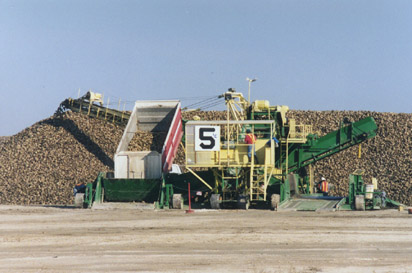|
By Lois Kerr
These small dumps remained in existence as long as they served a particular beet area. By 1959, with improved means of transportation, Holly Sugar had several established beet pile grounds scattered throughout seven different areas. The Buford-Trenton district had a dump at Marley, built in 1943 by a Holly employee, Santos Carranza, who along with four Mexican national laborers, built the Marley station during the fall of 1942 and the spring and summer of 1943. The Buford-Trenton district also had a receiving station at Dore and one at State Line. Fairview district had two receiving stations, Hardy and Ludington. Sidney area growers hauled their beets directly to the Sidney factory receiving grounds. The Savage district had four stations, Piche, Hoffmanville, Savage and Duell. The Glendive area had three stations, Glendive, Fallon and Terry. Miles City had three receiving stations, Benz, Kinsey and Muir, and the Forsyth area had four stations, Hathaway, Thurlow, Rosebud and Cold Springs. By 1968, locations of receiving stations had changed somewhat. The northern area still remained basically unchanged, but the Benz station at Miles City became part of the Glendive area, and the remaining two Miles City sites had closed. However, the factory at Sidney now accepted beets from Carrington, Bismarck and Fargo growers. The Holly Sugar Corporation needed a new plant, and they selected the Bismarck-Fargo area as a possible location for the proposed new facility. Growers in the Bismarck-Fargo area began growing beets with the idea of attracting the new plant to their area. Unfortunately for the Bismarck-Fargo growers, the Holly Sugar Corporation decided to build the new facility at Hereford, TX. By 1979, growers in the Bismarck-Fargo area no longer grew beets for the Sidney factory. With the ever-improving transportation, several receiving stations had closed down by 1979. The state line station in the Buford-Trenton district had closed down, leaving only Marley and Dore. Fairview had one station, simply called Fairview. Savage had gone from four stations to two, Hoffmanville and Rosenow, and Glendive had gone from three stations to two, Glendive and Fallon. By 1989, the Glendive and Fallon stations had consolidated into one station, Pleasant View. The years from 1989 to 1999 saw more stations consolidating, and more distance between each station. Today, Holly Sugar has six receiving stations, located from Fairview to west of Glendive. Fewer pile ground locations allows Holly Sugar to more easily manage and maintain the stations. As well, most area growers do not travel excessive distances to reach a station, with the exception of those growers in the Nesson Valley and a few of the growers in the Culbertson and Powder River areas. However, even with the receiving stations further apart, with faster and better equipment growers still can make more trips per day to a receiving station than their parents and grandparents could make using a horse and wagon. The six receiving stations today include the three-year-old Sugar Valley station, located at Fairview, which is a consolidation of the old Marley and Dore stations; the Sidney factory receiving station; the newest addition, a two-year-old receiving station located at Culbertson; the four-year-old Savage station, which consolidated the Hoffmanville and Rosenow sites; Pleasant View at Glendive, and Powder River, west of Glendive. Five agriculturists oversee the activities at the six receiving stations. The most northern site, Fairview's Sugar Valley, sits on a 50-acre site. The largest of the six stations, Sugar Valley has six pilers and employs 50 people during full harvest. This station runs two shifts during October's harvest. The Sidney factory pile grounds, the second largest receiving station, also runs two shifts during harvest. The Sidney factory pile grounds has five pilers and sits on a 33-acre site. Approximately 46 people work at this station during harvest, and growers bring in nearly 1,000 truckloads of beets per day during peak harvest. The other four stations are not as large as Sugar Valley and the Sidney factory pile grounds. All four of the smaller stations operate one shift per day during harvest, and all four sites have two pilers each. Powder River, the smallest of the receiving stations, employs eight people during harvest. Pleasant View employs 11 people for harvest, while Savage employs 10 and Culbertson employs 15. Holly Sugar has no new receiving stations planned for the near future. |
 When
Sidney's Holly Sugar opened the doors of the sugar processing plant in
October of 1925, the factory had a little over 8,000 acres of contracted
beets. Growers used horse power to harvest and transport their beets, so
many small receiving stations sprang up along the rail lines. Growers had
to have the capacity to haul several wagon loads of beets per day to the
receiving site, and Holly Sugar needed sites located along the rail road
lines, as rail transportation was the only available way to haul beets in
to the Sidney factory for processing.
When
Sidney's Holly Sugar opened the doors of the sugar processing plant in
October of 1925, the factory had a little over 8,000 acres of contracted
beets. Growers used horse power to harvest and transport their beets, so
many small receiving stations sprang up along the rail lines. Growers had
to have the capacity to haul several wagon loads of beets per day to the
receiving site, and Holly Sugar needed sites located along the rail road
lines, as rail transportation was the only available way to haul beets in
to the Sidney factory for processing.